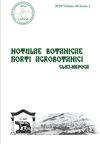亚热带气候下生长的三种火龙果的植物化学特性、抗氧化潜力和脂肪酸分析
IF 1.3
4区 生物学
Q3 PLANT SCIENCES
引用次数: 0
摘要
一种白浆的物理、生化及抗氧化性能研究DG-I)和两种红色果肉火龙果(H. polyrhizus, DG-II;测定了在印度西北部亚热带条件下生长的H. costaricencis, DG-III)。DG-III的果实大小、果实重、果肉重和果肉皮比显著高于其他品种,但单株果数和单株产量显著低于其他品种。各树种的pH、TSS、酸度、总糖、还原糖和水分含量分别为4.78 ~ 5.72、8.63 ~ 9.31、0.30 ~ 0.56%、6.64 ~ 6.91%、4.60 ~ 4.76%和83.44 ~ 85.82%。DG-I中总酚和黄烷醇含量分别为24.04 mg GAE 100 g−1和14.54 mg RE 100 g−1,而红浆中总酚和黄烷醇含量显著高于红浆;在49.12 ~ 56.40 mg GAE 100 g−1和30.41 ~ 31.10 mg RE 100 g−1果肉之间变化。红色火龙果果肉DG-II和DG-III的β-胡萝卜素含量分别为47.48和43.82µg 100 g−1,而白色火龙果果肉DG-I的β-胡萝卜素含量为1.96µg 100 g−1。同样,DG-II和DG-III中红火龙果的DPPH-RSC、FRAP、CUPRAC和ABTS值分别为238.98 ~ 262.04µmol 100g−1、358.8 ~ 386.40µmol TE 100g−1、830.40 ~ 917.0µmol TE 100g−1和571.4 ~ 589.60µmol TE 100g−1,而DG-I中的DPPH-RSC、FRAP、CUPRAC和ABTS值分别为108.75µmol 100g−1、192.6µmol TE 100g−1、525.6µmol TE 100g−1和400.2µmol 100g−1。在DG-II和DG-III中负责赋予红色的β-lain在白色浆的DG-I中缺失。两组火龙果的籽油含量在31.90 ~ 33.5%之间,其中必需脂肪酸亚油酸含量最高(46.32 ~ 47.96%)。综上所述,红皮火龙果比白皮火龙果具有更高的抗氧化潜力,红皮火龙果在确保发展中国家数百万人的营养安全方面可能发挥着至关重要的作用。本文章由计算机程序翻译,如有差异,请以英文原文为准。
Phytochemical properties, antioxidant potential and fatty acids profiling of three dragon fruit species grown under sub-tropical climate
The physical, biochemical and antioxidant properties of one white pulped (Hylocereus undatus; DG-I) and two red pulped dragon fruit species (H. polyrhizus, DG-II; H. costaricencis, DG-III) grown under sub-tropical conditions of north-west India were determined. Fruit size, fruit weight, pulp weight and pulp: peel ratio was significantly higher in DG-III, though the fruit numbers and yield per pillar was significantly less than other species. The pH, TSS, acidity, total sugar, reducing sugars and moisture content in all the species varied between 4.78-5.72, 8.63-9.31 oBrix, 0.30-0.56%, 6.64-6.91%, 4.60-4.76% and 83.44-85.82%, respectively. Total phenols and flavanols content in DG-I was 24.04 mg GAE 100 g−1 and 14.54 mg RE 100 g−1, whereas in red pulped it was significantly higher; varying between 49.12-56.40 mg GAE 100 g−1 and 30.41-31.10 mg RE 100 g−1 fruit pulp, respectively. β-carotene values in red pulped species DG-II and DG-III were 47.48 and 43.82 µg 100 g−1, respectively compared to corresponding values of 1.96 µg 100 g−1 in DG-I, a white pulped dragon fruit. Similarly, DPPH-RSC, FRAP, CUPRAC and ABTS values for red pulped dragon fruit ranged between 238.98-262.04 µmol 100 g−1, 358.8-386.40 µmol TE 100 g−1, 830.40-917.0 µmol TE 100 g−1 and 571.4-589.60 µmol 100 g−1, respectively in DG-II and DG-III in comparison to respective values of 108.75 µmol 100 g−1, 192.6 µmol TE 100 g−1, 525.6 µmol TE 100 g−1 and 400.2 µmol 100 g−1 in DG-I. The β-lain, responsible for imparting red colour in DG-II and DG-III was absent in white pulped DG-I. Seed oil content in both groups of dragon fruit varied between 31.90-33.5% with highest proportion of an essential fatty acid, linoleic acid (46.32-47.96%). In conclusion, red pulped dragon fruit has a considerably higher antioxidative potential than white one and these species may play a vital role in ensuring nutritional security for millions of people in developing nations.
求助全文
通过发布文献求助,成功后即可免费获取论文全文。
去求助
来源期刊

Notulae Botanicae Horti Agrobotanici Cluj-napoca
PLANT SCIENCES-
CiteScore
2.70
自引率
0.00%
发文量
118
审稿时长
3 months
期刊介绍:
Notulae Botanicae Horti Agrobotanici Cluj-Napoca is a peer-reviewed biannual journal aimed at disseminating significant research and original papers, critical reviews and short reviews. The subjects refer on plant biodiversity, genetics and plant breeding, development of new methodologies that can be of interest to a wide audience of plant scientists in all areas of plant biology, agriculture, horticulture and forestry. The journal encourages authors to frame their research questions and discuss their results in terms of the major questions of plant sciences, thereby maximizing the impact and value of their research, and thus in favor of spreading their studies outcome. The papers must be of potential interest to a significant number of scientists and, if specific to a local situation, must be relevant to a wide body of knowledge in life sciences. Articles should make a significant contribution to the advancement of knowledge or toward a better understanding of existing biological and agricultural concepts. An international Editorial Board advises the journal. The total content of the journal may be used for educational, non-profit purposes without regard to copyright. The distribution of the material is encouraged with the condition that the authors and the source (Notulae Botanicae Horti Agrobotanici Cluj-Napoca or JCR abbrev. title Not Bot Horti Agrobo) are mentioned.
 求助内容:
求助内容: 应助结果提醒方式:
应助结果提醒方式:


